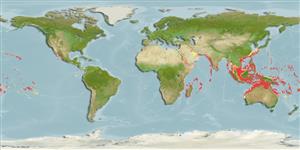Environment: milieu / climate zone / depth range / distribution range
Écologie
marin; saumâtre récifal; profondeur 3 - 158 m (Ref. 27665). Tropical; 32°N - 28°S
Indo-Pacific: Red Sea south to Algoa Bay, South Africa (Ref. 4329) and east to the Line, Marquesan, and Pitcairn islands, north to southern Japan and the Hawaiian Islands, south to New Zealand (Ref. 8879) and Rapa.
Taille / Poids / Âge
Maturity: Lm ? range ? - ? cm
Max length : 15.5 cm TL mâle / non sexé; (Ref. 90102)
Épines dorsales (Total) : 8; Rayons mous dorsaux (Total) : 9; Épines anales: 2; Rayons mous anaux: 8. Tan to light red brown in color, dusky scale margins; a brown mid-lateral stripe from tip of snout, through eye to upper caudal base (stripe may fade on peduncle); black spot at base of caudal fin (Ref. 2334, 4329). Further characterized by relatively broad midlateral dark stripe; yellow anterior margin on dorsal fin; green to blue iridescent shades on body when viewed with light at night; juvenile with yellowish head and belly; greatest depth of body 2.5-3.3 in SL (Ref. 90102).
Occurs in clear water lagoon patch reefs and seaward reefs from the lower surge zone to a depth of 45 m (Ref. 1602). Benthopelagic (Ref. 58302). Solitary (Ref. 93839). Feeds at night on small benthic and free-swimming crustaceans (Ref. 1602).
Life cycle and mating behavior
Maturité | Reproduction | Frai | Œufs | Fécondité | Larves
Mouthbrooders (Ref. 240). Distinct pairing during courtship and spawning (Ref. 205).
Myers, R.F., 1991. Micronesian reef fishes. Second Ed. Coral Graphics, Barrigada, Guam. 298 p. (Ref. 1602)
Statut dans la liste rouge de l'IUCN (Ref. 130435: Version 2024-2)
Menace pour l'homme
Harmless
Utilisations par l'homme
Pêcheries: commercial; Aquarium: Commercial
Outils
Articles particuliers
Télécharger en XML
Sources Internet
Estimates based on models
Preferred temperature (Ref.
123201): 23.9 - 28.9, mean 27.5 °C (based on 1254 cells).
Phylogenetic diversity index (Ref.
82804): PD
50 = 0.5312 [Uniqueness, from 0.5 = low to 2.0 = high].
Bayesian length-weight: a=0.01259 (0.00802 - 0.01977), b=3.14 (3.01 - 3.27), in cm total length, based on LWR estimates for this species & (Sub)family-body (Ref.
93245).
Niveau trophique (Ref.
69278): 3.5 ±0.0 se; based on diet studies.
Résilience (Ref.
120179): Haut, temps minimum de doublement de population inférieur à 15 mois (Preliminary K or Fecundity.).
Fishing Vulnerability (Ref.
59153): Low vulnerability (10 of 100).
Nutrients (Ref.
124155): Calcium = 90.3 [44.4, 154.1] mg/100g; Iron = 0.753 [0.439, 1.305] mg/100g; Protein = 18.9 [17.7, 20.0] %; Omega3 = 0.157 [0.090, 0.276] g/100g; Selenium = 38.9 [19.3, 77.7] μg/100g; VitaminA = 53.3 [13.9, 199.5] μg/100g; Zinc = 1.51 [1.01, 2.19] mg/100g (wet weight);
